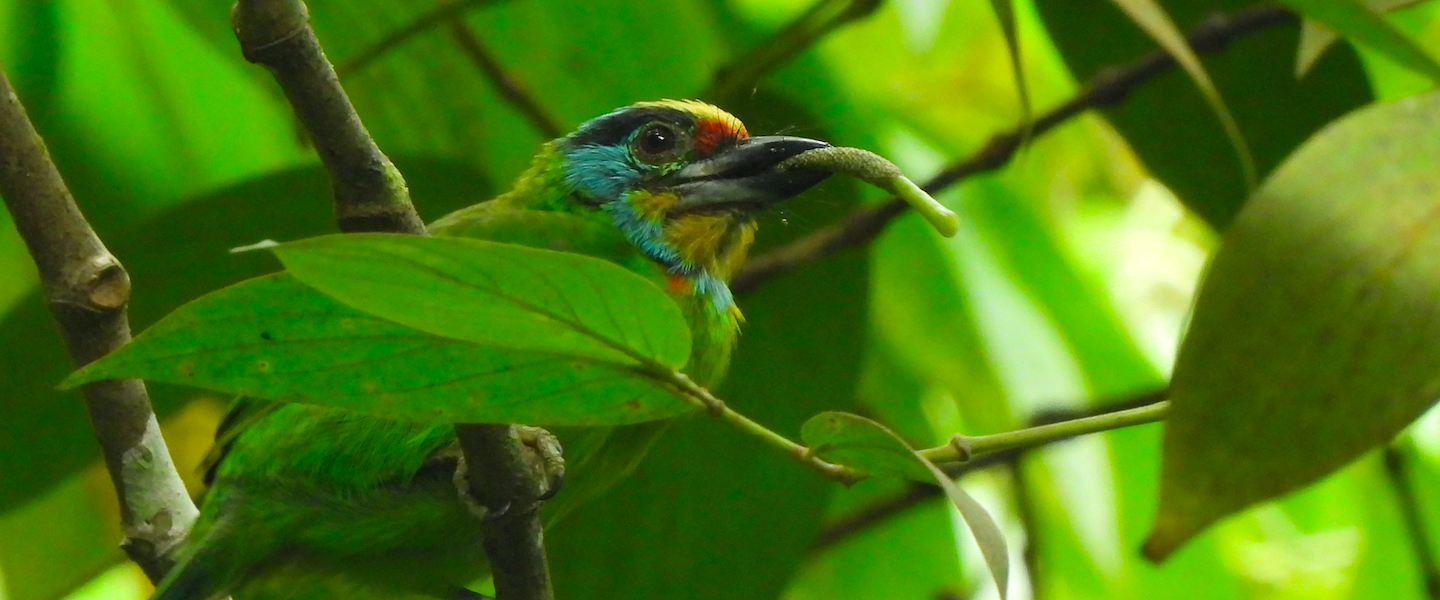A new joint project between the environmental consultancy Biocyma and the Ecology Department of Miguel Hernández University allowed us to monitor the bird diversity at one of the driest areas of southeast Spain. We surveyed Cabo Cope y Puntas de Calnegre, where we put the focus on two desert-dwelling specialties with narrow breeding ranges within the Iberian Peninsula — the trumpeter finch (Bucanetes githagineus) and the rufous-tailed scrub-robin (Cercotrichas galactotes). This area of southern Murcia is an important stronghold for both species despite not being officially surveyed for decades.

We immersed in the colors of the onset of a rainy spring on our first visit in late March. Puddles in the fields featured opportunistic migrants such as little ringed plovers (Thinornis dubius), common sandpipers (Actitis hypoleucos), meadow pipits (Anthus pratensis) and western yellow wagtails (Motacilla flava). The heads of red-legged partridges (Alectoris rufa) popped out of the grass but the few common quails (Coturnix coturnix) present remained hidden while calling from the fields.

Multicolored fields were flanked by rugged sandstones carved by empty riverbeds. The holes of these small cliffs are favored by black wheatears (Oenanthe leucura) and blue rock thrushes (Monticola solitarius), busy defending their territories in early spring. Around these areas, Thekla’s larks (Galerida theklae), Sardinian warblers (Curruca melanocephala) and corn buntings (Emberiza calandra) outnumbered all other bird species.

Cabo Cope is a cabezo (hill) around 250 m high surrounded by crystal-clear waters. A morning survey provided migrant song thrushes (Turdus philomelos) sedimented in an odd place, a dry slope covered in esparto grass (Macrochloa tenacissima). Darftord warblers (Curruca undata), rock buntings (Emberiza cia) and golden eagles (Aquila chrysaetos) seemed best suited in the area.

Most importantly, we observed trumpeter finches in Cabo Cope twice: a pair foraging on a cliff adjacent to the sea, and a small group flying over the foothill vegetation close to Calabardina village. This desert-dweller was originally distributed from Sahara east to central Asian plains, but recently colonized southeast Spain — with a first confirmed reproduction event in Spain in 1971, and notes on reproduction in this same area in the late 1980s.

Marina de Cope plains surrounding the cabezo bear some treasures. Besides holding a population of Greek tortoise (Testudo graeca), we encountered different greater short-toed larks (Calandrella brachydactyla) and Mediterranean short-toed larks (Alaudala rufescens) very close to the sea.

Migrants were everywhere in Marina de Cope in March, with great observations of bee-eaters (Merops apiaster), common redstart (Phoenicurus phoenicurus), common nightingale (Luscinia megarhynchos), western black-eared wheatear (Oenanthe hispanica), northern wheatear (Oenanthe oenanthe), sedge warbler (Acrocephalus schoenobaenus) and greater whitethroat (Curruca communis) all among esparto grasses and other shrubs.

While migrants were less evident later in the spring, our next visit in mid May provided great observations of rufous-tailed scrub-robins. After finding a Bedriaga’s skink (Chalcides bedriagai) and gazing a peregrine falcon (Falco peregrinus) spectacularly chasing some collared doves (Streptopelia decaocto), we heard a first scrub-robin and enjoyed great looks. Males sing cooperatively for us birdwatchers, exposed on top of shrubs, protecting their piece of land from adjacent territories that can be as close as only 100 m apart.

During survey breaks, we would help on a parallel project monitoring scrub-robin territories this year and aiming at ringing individuals. Despite their wide distribution from Balkans east to Central Asia and all around the Sahel, only few dry areas in the Iberian Peninsula gather the entire population of the species in western Europe. All time low numbers fluctuate, and the efforts of this project hope to better understand the trends and needs of this desert-dweller in the region.

Instead, this week was plenty of observations of reproduction. Fledgling Sardinian warblers, black wheatears and rock buntings were seen around Cabo Cope where adults marked territories two months before. A juvenile trumpeter finch was most welcome. On a riverbed nearby, we enjoyed the business of a family of spectacled warblers (Curruca conspicillata) with cooperative fledglings.

Walking by the sea in our latest visit was a joy — and we did enjoy some fresh dip! Scopoli’s shearwaters (Calonectris diomedea) foraged incredibly close to the shore, and we could see some European shags (Gulosus aristotelis), yellow-legged gulls (Larus michahellis) and Audouin’s gulls (Ichthyaetus audouinii) on different outings. Good numbers of pallid swifts (Apus pallidus), red-rumped swallows (Cecropis rufula) and even alpine swifts (Tachymarptis melba) filled the sky too. But the highlight of these walks was a bloom of duendes (Spanish for elf), a stunning spoonwing endemic to the Iberian Peninsula (Nemoptera bipennis).

Nocturnal surveys made work days long but even more eventful. We had a blast in March hearing at numerous scops-owls (Otus scops), little owls (Athene noctua) and eagle-owls (Bubo bubo) in the right habitat around a montane area. Riverbeds with some water flowing featured numerous natterjacks (Epidalea calamita) and parsley frogs (Pelodytes punctatus) and some spiny toads (Bufo spinosus) calling.

While May produced less vocal owls, we connected with different newcomer red-necked nightjars (Caprimulgus ruficollis) and good numbers of Pérez’s frogs (Pelophylax perezi) singing loudly. We also bumped into a sounder of wild boars (Sus scrofa) with several piglets around a riverbed.

This dry corner of Spain is currently under threat of being fully transformed by a resort complex. Few coastal areas in the Spanish Mediterranean remain well preserved, and our encounters with unique fauna and flora within our short visits to the area fully justify the protection of the area.




